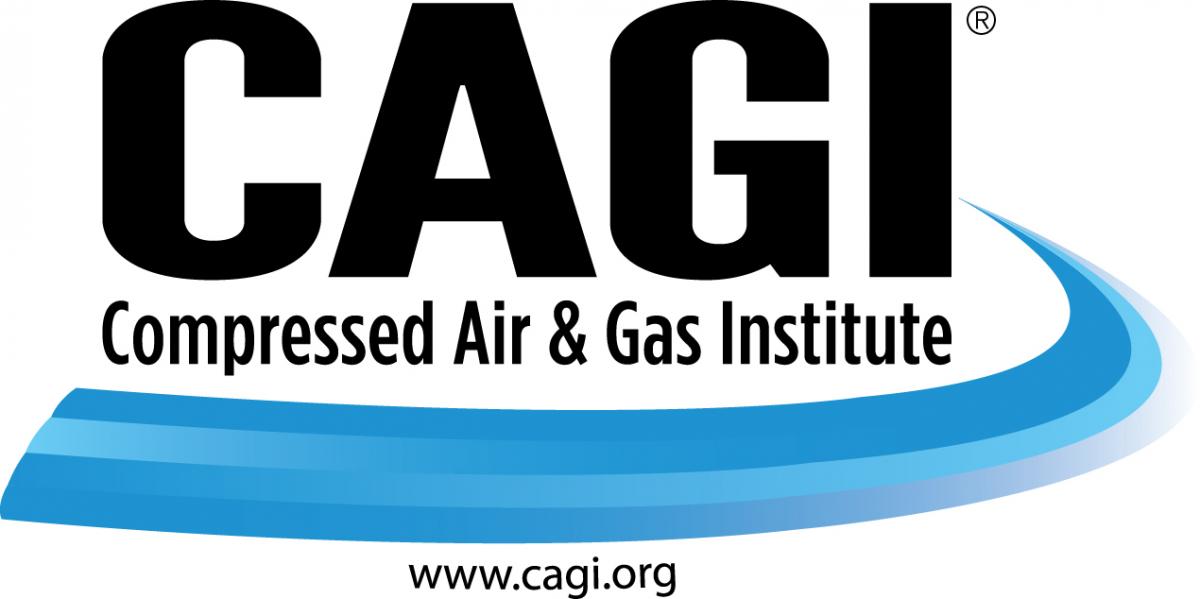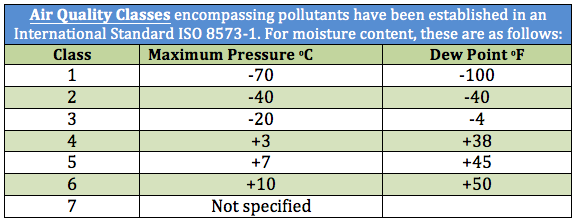Introduction
Mention utilities and energy in a discussion about manufacturing and the Big Three - water, electricity and natural gas - immediately come to mind. But compressed air is commonly accepted as a manufacturing facility's fourth utility. A careful examination of a facility's compressed air system will likely reveal several opportunities to improve the performance of the system by effectively and efficiently removing moisture that may be present. The Compressed Air and Gas Institute (CAGI) will be issuing a series of articles discussing moisture in the compressed air system and will provide a brief overview of the compressed air drying technologies available.
Why Do Compressed Air Systems Need Drying?
Moisture is Always Present
All atmospheric air contains some water vapor, which will begin to condense into liquid water in the compressed air or gas system when the air or gas cools past the saturation point, i.e., the point where it can hold no more water vapor. The temperature at which this happens is known as the dew point. This dew point becomes all-important in determining how much compressed air drying is needed.
The increased use of compressed air and the development over the years of many new and more sophisticated devices and controls has increased the need for clean dry air. Hence, drying technology advanced, and dryers came into general use. CAGI and their Air Drying & Filtration Section remain committed to educate users on this topic.
Moisture is Damaging.
Moisture in compressed air used in a manufacturing plant causes problems in the operation of pneumatic systems, solenoid valves and air motors and can adversely affect the process or product being manufactured. For many years, problems from moisture in compressed air lines were simply tolerated as unavoidable. Moisture:
- Causes rust and increased wear of moving parts in production equipment as it washes away lubrication
- Can adversely affect the color, adherence, and finish of paint applied by compressed air
- Can jeopardize process industries where many operations are dependent upon the proper functioning of pneumatic controls. The malfunctioning of these controls due to rust, scale, and clogged orifices can result in damage to product or in costly shutdowns
- Can freeze in control lines in cold weather, which may cause faulty operation of controls
- Causes corrosion of air or gas operated instruments, giving false readings, interrupting or shutting down plant processes.
Plant Air – In almost every operation, clean, dry compressed air will result in lower operating costs. Dirt, water and oil entrained in the air will be deposited on the inner surfaces of pipes and fittings, causing an increase in pressure drop in the line which results in a loss of performance efficiency.
Liquid water accelerates corrosion and shortens the useful life of equipment and carry- over of corrosion particles can plug valves, fittings and instrument control lines. When water freezes in these components, similar plugging will occur.
Balancing Energy Efficiency & Dewpoint with Desiccant Dryers - Webinar RecordingDownload the slides and watch the recording of the FREE webcast to learn:
|
Valves and Cylinders – Deposits of sludge formed by dirty, wet and oily air, acts as a drag on pneumatic cylinders so that the seals and bearings need more frequent maintenance intervals. Operation is slowed down and eventually stopped. Moisture dilutes the oil required for the head and rod of an air cylinder, corrodes the walls and slows response. This results in loss of efficiency and production.
Moisture flowing to rubber diaphragms in valves can cause these parts to stiffen and rupture. Moisture also can cause spools and pistons to pit. In high-speed production, a sluggish or stuck cylinder could create costly downtime. A clean, dry air supply can prevent many of these potential problems.
Air Powered Tools – Pneumatic tools are designed to operate with clean, dry air at the required pressure. Dirty and wet air will result in sluggish operation, more frequent repair and replacement of parts due to sticking, jamming and rusting of wearing parts. Water also will wash out the required oils, resulting in excessive wear. A decrease in pressure at the tool caused by restricted or plugged lines or parts will cause a reduction in the efficiency of the tool.
Clean, dry air at the required pressure will enable the production worker to start operating immediately at an efficient level, with no time lost to purge lines or drain filters and will help to maintain productivity and prolong tool life.
Instrument Air – Control air supplied to transmitters, relays, integrators, converters, recorders, indicators or gauges is required to be clean and dry. A small amount of moisture passing through an orifice can cause malfunction of the instrument and the process it controls. Moisture and resultant corrosion particles also can cause damage to instruments and plug their supply airlines. Pneumatic thermostats, which control the heating and air conditioning cycles in large and small buildings, also require clean, dry air.
Instruments and pneumatic controllers in power plants, sewage treatment plants, chemical and petrochemical plants, textile mills and general manufacturing plants, all need clean, dry air for efficient operation.
Preservation of Products – When used to mix, stir, move or clean a product, air must be clean and dry. For example, oil and water in compressed air used to operate knitting machinery will cause the tiny latches on the knitting needles to stick. When used to blow lint and thread off finished fabrics, contaminants in the air may cause product spoilage.
If air is used to blow a container clean before packaging, entrained moisture and oil may contaminate the product. Moisture in control line air can cause the wrong mixture of ingredients in a bakery, the incorrect blend in liquor, waterlogged paint, or ruined food products.
In some printing operations, air is used to lift or position paper, which will be affected by dirty, wet air and any water on the paper will prevent proper adhesion of the inks.
In pneumatic conveying of a product such as paper cups or cement, dry air is essential.
Test Chambers – Supersonic wind tunnels are designed to simulate atmospheric conditions at high altitudes where moisture content is low. These chambers use large volumes of air, which must be dried to a very low dew point to prevent condensation in the tunnel air stream.

Selecting the Right Compressed Air Dryer
Before looking at the several types of dryers available, we need to look at what to consider in deciding which dryer is best for the specific requirements.
Know the Specific Uses of the Compressed Air – The selection of an air dryer is done best by the professional who knows or learns the particular end uses, the amount of moisture which each use can tolerate and the amount of moisture which needs to be removed to achieve this level. Air, which may be considered dry for one application, may not be dry enough for another. Dryness is relative. Even the desert has moisture. There is always some moisture present in a compressed air system regardless of the degree of drying.
For compressed air, the best way to specify dryness is to cite a desired pressure dew point. Different types of dryers, therefore, are available with varying degrees of pressure dew point performance. To specify dew point lower than required for an application is not good engineering practice. (Naming a pressure dew point is how to state the degree of dryness wanted.) It may result in more costly equipment and greater operating expense.
Know the Temperatures – To determine whether or not the compressed air will remain sufficiently dry, we must know the end use of the air and the temperature at which it must work. In an industrial plant where the ambient temperature is in the range of 70ᵒF or higher, a dryer capable of delivering a pressure dew point 20ᵒF lower than ambient, or 50ᵒF, may be quite satisfactory.
Summer temperatures do not require a very low dew point whereas winter temperatures may dictate a much lower dew point. In winter, the temperature of the cooling medium, air or water, usually is lower than in summer, resulting in a variation of the air temperature to the dryer. This will affect the size of the dryer needed, since the same dryer must work in both summer and winter temperatures and relative humidities.
Compressed Air Purification & Piping Monthly e-NewsletterWith a focus on Demand-Side Optimization, compressed air dryers, filters, condensate management, tanks, piping and pneumatic technologies are profiled. How to ensure system reliability, while reducing pressure drop and demand, is explored through System Assessment case studies. |
Many chemical processing plants, refineries, and power plants distribute instrument and plant air throughout the facility with lines and equipment located outside the buildings. In such plants two different temperature conditions exist at the same time in the same system. Also, a dryer which may be satisfactory for high daytime temperatures, may not be satisfactory for lower nighttime temperatures. In areas where freezing temperatures are encountered, a lower pressure dew point may be required. In general, the dew point should be specified 20ᵒF lower than the lowest ambient temperature encountered in order to avoid potential condensation and freezing. To specify a winter dew point when only summer temperatures will be encountered, can result in over-sizing the equipment and increased initial and operating costs. A system designed to dry air for cold weather conditions will greatly increase operating costs if used year round.
For plant air and instrument air, primary considerations in specifying a dryer are condensation and freezing. In a system where a lot of internal pipe corrosion could occur, high humidity in the air stream should be avoided.
Know the Actual Performance – While many dryers have a standard rating of 100ᵒF saturated inlet air temperature and 100 PSIG operating pressure, it is important to check on the actual performance of the units obtained in actual plant operating conditions.
Know Each Use – In addition to plant and instrument air applications, there are many other uses requiring moisture removal to a low dew point. For example, railroad tank cars, which carry liquid chlorine, are padded (charged) with compressed air to enable pneumatic unloading. Chlorine will combine with water vapor to form hydrochloric acid; therefore, the compressed air must have minimum moisture content to prevent severe corrosion. Droplets of moisture in wind tunnel air at high- testing velocities may have the effect of machine gun bullets, tearing up the test models. Air used for low temperature processing (for example, liquefaction of nitrogen or oxygen) can form ice on cooling coils, thus requiring defrosting. The lower the moisture content of the air, the longer the periods between defrosting shutdowns.
For these and similar temperature applications, compressed air must not only be free of liquid phase water but must also have a minimum content of vapor phase water. Usually specified for these requirements are dew points in the range of -40ᵒF to -100ᵒF at pressure.
Compressed Air & Gas Institute – The Compressed Air and Gas Institute is the united voice of the compressed air industry, serving as the unbiased authority on technical, educational, promotional, and other matters that affect the industry. The next article in the series will focus on the different types of compressed air dryers and the features and benefits of each type.
For more detailed information about Compressed Air Dryers, CAGI, its members, compressed air applications and other educational resources on compressed air, visit the CAGI web site at www.cagi.org.
To read more Air Treatment Technology articles please click here.




